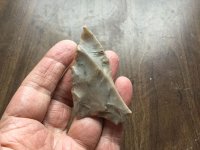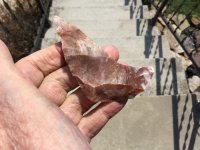uniface
Silver Member
It annoys me when people keep posting pictures of the same artifact, but this, IMO, is warranted -- for the sake of people in years to come, if not at present.
While it's highly unlikely that you'll ever encounter one of these in the field, if you do, you'll be on a Paleo habitation site -- one far from that group's home, where they were making tools/points from platter-like bifacial cores carried in with them as efficient, easily portable raw material.
The more flakes were removed from these for use as tools (or tool stock), the thinner the flakes got until a point was reached when the next step was to split them into pieces suitable for turning into points (or whatever). When things went not exactly according to plan, smallish, odd-shaped pieces resulted that, in the cases of the following two examples, were discarded for people to find in modern times. These are, literally, lithic snapshots that document their reduction procedure.
Keys to recognizing these are the long, twisting break surfaces that rotate from initial low-angles to 90 degrees as they travel (easily seen on the first example), and the wide, flat-ish, parallel facial removals from previous flake detachments.
Putting both together here in their own little thread as I doubt whether many people remember the first one by now.
1. Texas: Edwards Plateau Chert. From a Golondrina site. Gifted by a Texan many years ago at A'ology whose name/screen name I've unfortunately forgotten.

2. Pasco County, Florida. Gift from newnanman.

While it's highly unlikely that you'll ever encounter one of these in the field, if you do, you'll be on a Paleo habitation site -- one far from that group's home, where they were making tools/points from platter-like bifacial cores carried in with them as efficient, easily portable raw material.
The more flakes were removed from these for use as tools (or tool stock), the thinner the flakes got until a point was reached when the next step was to split them into pieces suitable for turning into points (or whatever). When things went not exactly according to plan, smallish, odd-shaped pieces resulted that, in the cases of the following two examples, were discarded for people to find in modern times. These are, literally, lithic snapshots that document their reduction procedure.
Keys to recognizing these are the long, twisting break surfaces that rotate from initial low-angles to 90 degrees as they travel (easily seen on the first example), and the wide, flat-ish, parallel facial removals from previous flake detachments.
Putting both together here in their own little thread as I doubt whether many people remember the first one by now.
1. Texas: Edwards Plateau Chert. From a Golondrina site. Gifted by a Texan many years ago at A'ology whose name/screen name I've unfortunately forgotten.

2. Pasco County, Florida. Gift from newnanman.

Amazon Forum Fav 👍
Last edited:
Upvote
0




